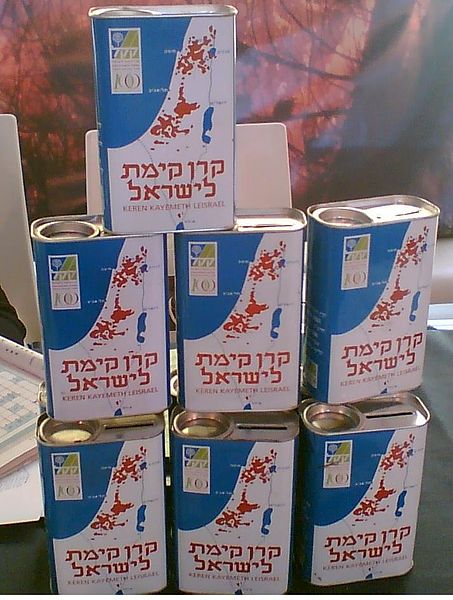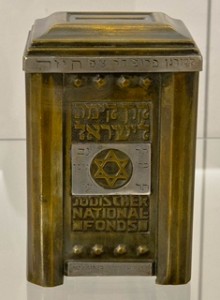
Yesterday, I wrote about the memorial tree planted for Kamilla, the mother of Viktor and Bertschi Kornmehl, tracing it to a project designed to pay tribute to the memory of Rabbi Zvi Perez Chajes.
I wondered what happened to the Chajes Forest and Kamilla’s tree and set out to find them. I didn’t succeed, but the search shook loose some memories.
The Tradition of Tree Planting
The Chajes Forest seems to have disappeared without a trace; perhaps it was enchanted. But I did find Rabbi Chajes mentioned in a March 4, 2012 Jerusalem Post article discussing the celebration of the 110th anniversary of the Keren Kayemeth LeIsrael-Jewish National Fund (KKL-JNF) with an exhibition called “The Vienna Woods in Israel,” held in the Jewish Museum of Vienna. The exhibition traces the history of the organization and explains the connection to Vienna:
The first World Chairman of KKL-JNF was Johann (Yonah) Kremenezky, a Viennese industrialist and therefore the first head office was located in Vienna. Kremenezky initiated and implemented the Blue Box, the organisation’s symbol, and many different Blue Boxes are on display. A very special piece on display is a KKL-JNF Box in Art Deco style, which the chief Rabbi of Vienna, Zvi Perez Chajes, received as a present from the Jewish community in Trieste in 1919. On display are also some covers of the Golden Book and the very first page of the first Golden Book with signatures of Theodor Herzl and other important personalities of the time.
Blue Boxes and Golden Books
I wasn’t sure what Blue Boxes and the Golden Book were, but it looked to me like Rabbi Chajes’ golden KKL-JNF box, pictured below, confused the color scheme.
More to the point, the Jerusalem Post article assumed everyone would know what the Keren Kayemeth LeIsrael — Hebrew for the Jewish National Fund — and the Blue Boxes and Golden Book were.
I didn’t.
Certainly, the organization sounded vaguely familiar to me, but not familiar enough that I didn’t have to look it up. According to the history section on the KKL-JNF’s website, it started in 1901 as a fund to buy land in Ottoman Empire-controlled Palestine, with the ultimate goal of establishing a Jewish state. Trees began being planted in 1905 as part of a desert reclamation effort. The Golden Book, initiated by Viennese Industrialist Yona Krementzy, was one form of fundraising, “recording special moments in the lives of inscribers, or those they wish to honor, with paid inscriptions.”
But it was the blue boxes that became best known:
Krementzky also adopted the suggestion of a small-town Galician bank clerk, Haim Kleinman, who had written to the Zionist movement’s newspaper Die Welt, proposing that a collection box be placed in every Jewish home so that contributions could be made to JNF at every opportunity. In the period between the two World Wars, about one million Blue Boxes could be found in Jewish homes throughout the world.
Suddenly memories of Hebrew school collection boxes and exhortations to plant trees in Israel came back to me. I knew it was supposed to be an important thing for Jews to do, but I didn’t understand why. If my parents ever told me, it didn’t sink in. We didn’t have family there, as far as I knew.
Now I’m discovering that we did — not only Viktor and Bertschi’s families but also Ezriel’s. Other relatives, I’m learning, also went to Israel for varying periods of time. And I’m beginning to understand, on a visceral, beyond-the-movie-Exodus level, what it meant for the Jews of Europe to have Palestine as a refuge, and to admire those family members who were prescient enough — and brave enough, in the rising tide of Nazism — to work towards establishing that safe haven.
A Somewhat Woo-Woo Addendum
I was always drawn to desert lands — Egypt more than Israel, as it happens, because I was interested in the art — and when I first visited the Southwest U.S. I felt like I had come home. I moved to Tucson 20 years ago.
In researching this post, I saw that in 1991, the U.S. branch of the Jewish National Fund founded the International Arid Lands Consortium, dedicated to “Promoting Peace Through Collaborative Research & Development.” One of the partners in promoting scientific research is the University of Arizona in Tucson; it hosts the organization’s website and is listed as its managing director.
The Ministry of Agriculture and Land Reclamation-Egypt is the only other country, outside the U.S. and Israel, listed as participating in the consortium.
This is Day 17 of the Family History Writing Challenge. I am seeing the trees in the forest… or is that the light at the end of the tunnel?

the blue boxes – Yes!! I remember. And. I will have to check out that land institute in Tucson – especially something the tribes in Arizona would be interested in
It’s funny, I didn’t know the institute existed. So many interesting things going on here, like Native Seed/Search too.